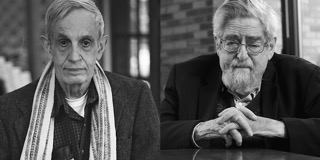
The Abel Prize Laureates 2015 John F. Nash Jr. and Louis Nirenberg visit University of Bergen.
TIME: Thursday May 21, 14:00 – 16:00
PLACE: VilVite Auditorium, Thormøhlensgate 51.
PROGRAM:
Introduction: Rector Dag Rune Olsen, Universitetet i Bergen
John F. Nash Jr. of Princeton University
Louis Nirenberg of New York University’s Courant Institute of Mathematical Sciences
Science Lecture: Camillo De Lellis, University of Zürich:
Part 1: «Surely you’re joking, Mr. Nash?”
Part 2: “Exploring the unknown, the work of Louis Nirenberg on Partial Differential Equations”
About the prize winners:
John F. Nash, Jr. of Princeton University and Louis Nirenberg of New
York University’s Courant Institute of Mathematical Sciences share
the Abel prize 2015
“for striking and seminal contributions to the theory of nonlinear
partial differential equations and its applications to geometric
analysis.”
Partial differential equations (PDEs) are equations involving rates of
change that originally arose to describe physical phenomena but, as
they showed, are also helpful in analysing abstract geometrical
objects.
In the 1950s Nash proved important theorems about PDEs, which are
considered by his peers to be his deepest work. Outside mathematics,
however, Nash is best known for a paper he wrote
about game theory, the mathematics of decisionmaking, which ultimately
won him the 1994 Nobel
Prize for economics, and which features strongly in the 2001 film
about him, A Beautiful Mind.
Nirenberg, with his fundamental embedding theorems for the sphere,
solved the classical problems of Minkowski and Weyl. Nirenberg has
had one of the longest and most feted careers in mathematics, having
produced important results right up until his 70s. Besides being
towering figures, as individuals, in the analysis of PDEs, Nash and
Nirenberg influenced each other through their contributions and
interactions. Far from being confined to the solutions of the
problems for which they were devised, the results proved by Nash and
Nirenberg have become very useful tools and have found tremendous
applications in further contexts. Among the most popular of these
tools are the interpolation inequalities due to Nirenberg.
